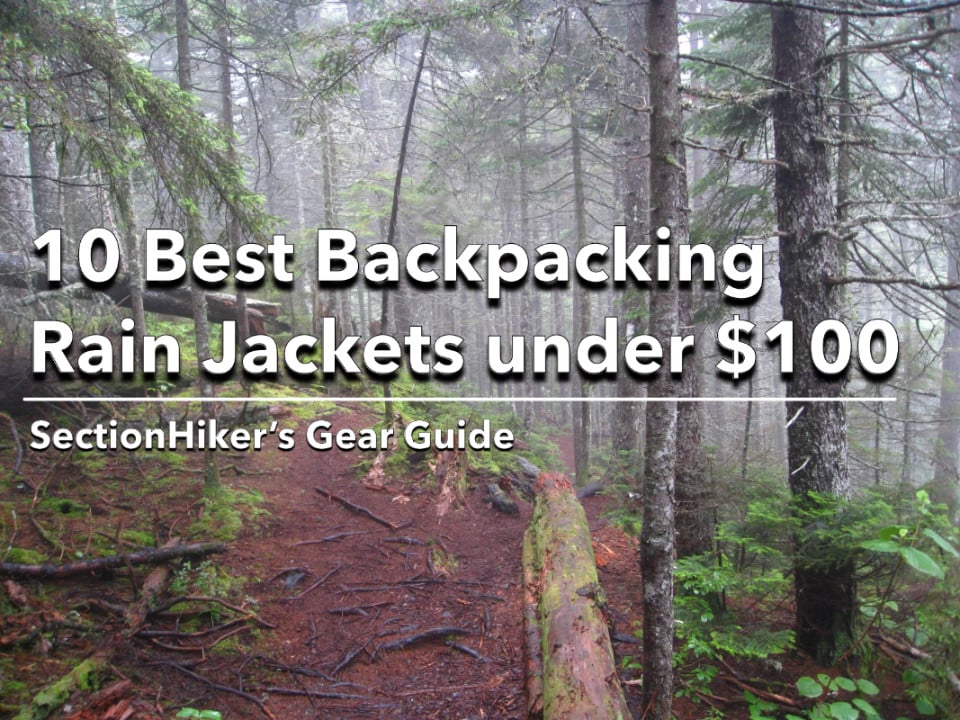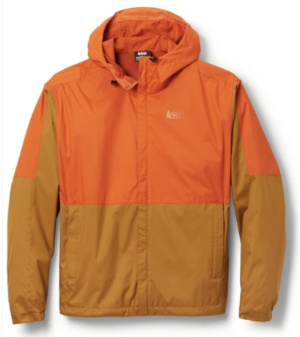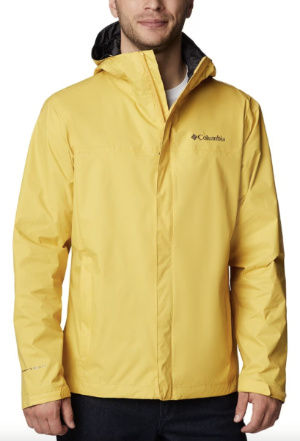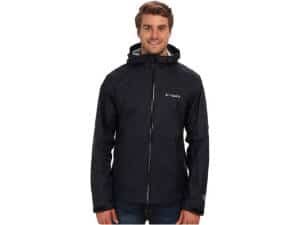
You don’t need to buy an expensive rain jacket for hiking and backpacking because an inexpensive one will work just as well as one costing an arm and a leg. In fact, most backpackers use rain jackets that cost $100 or less for just this reason. While outdoor clothing manufacturers and the media rave about the breathability of Gore-tex, eVent, Futurelight (and dozens of other waterproof/breathable membranes), the fact is they work poorly for hikers because they can’t keep up with the perspiration and condensation inside a rain jacket when you’re carrying a backpack in the rain all day.
Here are the top 10 rain jackets that cost less than $100.
| Make / Model | Avg Weight |
|---|---|
| Marmot Precip Eco Rain Jacket | 10.6 oz |
| REI Rainer Rain Jacket | 12.5 oz |
| Frogg Toggs UL2 Rain Jacket | 5.5 oz |
| Frogg Toggs Xtreme Light Rain Jacket | 7.6 oz |
| Compass 360 Ultrapak UL Rain Jacket | 7.8 oz |
| REI Trailmade Rain Jacket | 11.5 oz |
| Columbia EvaPOURation Jacket | 12.0 oz |
| Warbonnet Stash Jacket | 5.3 oz |
| Sea-to-Summit Ultra-Sil Nano Poncho | 5.2 oz |
| Columbia WaterTight II Rain Jacket | 13.5 oz |
If staying perspiration-free in the rain is important to you while you’re hiking down a trail carrying a loaded backpack…maybe you should pick another sport. Perspiring is inevitable. So is condensation, when the interior of your rain jacket is warmer than the exterior surface. Think of a rain jacket as part of your larger layering system instead. The main purpose of a rain jacket is to keep you warm when it’s raining or the wind is blowing hard when used in combination with a mid or base layer. Your goal should be to stay warm and avoid hypothermia.
Waterproof/Breathable or Not?
The ultimate question is whether you should bother buying a waterproof/breathable jacket with crummy breathability specs or one that’s waterproof but not breathable since you’re going to get wet inside anyway. While heavier, many waterproof/breathable jackets are better quality than non-breathable ones with more features, including taped seams. They’re often warmer too. Whatever you decide, pay close attention to the features of the jackets you’re comparing. We think the most important rain jacket features are three-way adjustable hoods, pit zips, zippered pockets, and taped seams, followed by velcro wrist cuffs and hem adjusters.
DWR Coatings
If you do buy a waterproof/breathable jacket that is coated with a chemical DWR layer (durable water repellent) that makes water bead when it hits the fabric and rolls off. The downside of this design is that the DWR coating rubs off with use. When this happens your jacket will remain waterproof, but it will cease to be breathable at all. When that happens, most backpackers buy a new jacket, on average every 2-3 years, instead of trying to restore the DWR coating with a product like Nikwax TX Direct. Alternatively, many hikers and backpacks buy rain jackets that are made with non-breathable fabrics. Many of those rain jackets have pit-zips and other venting features to help reduce internal sweat build-up when it rains instead of breathability.
1. Marmot Precip Eco
| Shop at REI | Shop at Amazon |
2. REI Rainier Rain Jacket
The REI Rainier Rain Jacket is nearly identical to the Marmot Precip. It includes pits zips, a three-way adjustable hood, hook and loop wrist cuffs, and zippered side pockets, which are highly desirable on rain jackets intended for hikers and backpackers. The Rainier has two zippered pockets, both lined with mesh. Both pockets are enormous and can hold lots of gloves, hats, or snacks. They can also be used as a stuff pocket to store the jacket when not in use. Read the SectionHiker review.
3. Frogg Toggs UL2 Rain Jacket
4. Frogg Toggs Xtreme Lite
5. Compass 360 Ultrapak Ultra-Lite Rain Jacket
6. REI Trailmade Rain Jacket

7. Columbia EvaPOURation Omni-Tech Jacket
| Shop at REI | Shop at Amazon |
8. Warbonnet Stash Jacket
9. Sea-to-Summit Ultra-Sil Nano Tarp Poncho
10. Columbia Watertight II Rain Jacket

HOW TO BUY A BACKPACKING RAIN JACKET
What are the most important features to look for on a hiking and backpacking rain jacket?
Adjustable Hoods
When choosing a rain jacket make sure the hood is NOT helmet-compatible, unless you have a huge Godzilla-sized head. Unfortunately, many rain jackets are intended for skiers and climbers who wear protective helmets. What you should look for is a fully adjustable hood with a rear volume adjustment so you can shrink the hood size to fit your head, side pulls so you can adjust the size of the face opening, a wire or shapeable brim to shield your eyes from wind and snow, and a high collar that covers your neck and mouth. All of these features will help protect your face from the cold and wind and help you stay warmer.
Zippered Pockets
You can’t have too many rain jacket pockets. They’re great for carrying spare gloves, hats, and keeping navigation tools in easy reach. They’re also good for keeping snacks close at hand so you can eat while you hike. I view rain jacket pockets as an extension of my backpack because the extra storage cuts down on the number of times I have to stop to get clothes or food out of my pack.
Venting Capabilities
When you have to hike in cool wet weather, you want to limit the amount you perspire by actively managing your warmth level. The key to doing this involves venting excess warmth by removing or venting layers. A good rain jacket should provide several ways for you to dump excess heat without having to take it off completely. Here are some of the most important features to look for when comparing different jackets.
- Adjustable Hook and Loop (Velcro) Wrist Closures: These help regulate the body heat at your wrists where the blood flows close to the surface of your skin. They can be worn under gloves or over them depending on your preference and the glove type.
- Two way-front zipper: If you pull the bottom half up, you can dump a lot of excess torso heat, poncho-style.
- Hem drawcord: Cinch it closed to keep the wind from blowing up between your legs and robbing your torso heat.
Breathability Ratings
What should you look for in terms of breathability ratings when looking at hiking rain jackets? For inexpensive rain jackets, the best you can hope for is 10,000 (g/m^2/d) MVTR (movable water vapor transmission rate), which is pretty lackluster. Most of the manufacturers listed above don’t publish the MVTRs for their jackets, because they’re not that competitive with more expensive garments,
But to be honest, I don’t trust the breathability ratings published by manufacturers because they’re measured in ideal laboratory conditions that have little to do with actual use. Pit zips and active venting trump breathability claims any day. If you get too hot, venting your rain jacket is going to cool and dry you off far more quickly than waiting for water vapor to move across a breathable membrane while your zipper is closed.
Check Out All of SectionHiker's Gear Guides!
- 10 Best Hiking Shoes and Trail Runners
- 10 Best 2-Person Backpacking Tents
- 10 Best 1-Person Backpacking Tents
- 10 Best Backpacking Stoves
- 10 Best Backpacking Water Filters
- 10 Best Lightweight Backpacks
- 10 Best Ultralight Backpacks
- 10 Best Backpacking Sleeping Bags
- 10 Best Ultralight Backpacking Quilts
- 10 Best Lightweight Backpacking Chairs
- 10 Best Backpacking Sleeping Pads
- 10 Best Backpacking Rain Jackets
- 10 Best Hiking Daypacks
- 10 Best Hiking Pants
- 10 Best Trekking Poles
 SectionHiker.com Backpacking Gear Reviews and FAQs
SectionHiker.com Backpacking Gear Reviews and FAQs 







Exactly.
Anyone knows good rain jackets that are longer (above the knee)?
They’re called “cagoule” and are available in Amazon, and various outfitters selling back country items. Also terrific for canoeing!
Montbell Versatile, best rain jacket I’ve ever owned
Not exactly under $100, but I agree with you. It’s my goto as well for 3-season hiking.
I’d spend the extra $50 to buy the Lightheart Gear rain jacket. Made in the US and completely waterproof with no problematic DWR. Mine, purchased several years ago for around $100 has kept me dry on the PCT and Long Trail.
I really wanted to like my Lightheart Gear jacket, but after a couple of years it started peeling right at where the hood joins the torso, leaking water down my neck (exactly where every other jacket I’ve ever had gives out). I pickup up an Antigravity Gear jacket for $99 on sale (which you can do often enough I think it should make this list). It will probably do the same thing eventually.
the LHG is now made with a completely different fabric and seam-taped, so it really is a very different jacket than what you bought. It’s also more expensive and doesn’t make the $100 cutoff anymore.
That’s pretty sexist as I don’t see any womens rain jackets here!!
For the Warbonnet, why do you recommend the quilt fabric over the fully waterproof tarp fabric? Normally I subscribe to the “nothing is truly breathable, so mechanically vent” school. Do you feel the quilt fabric is sufficiently waterproof to use as a true rain jacket while actually being breathable?
The EMS Thunderhead is my go to rain gear. I’m surprised it didn’t make the list.